932 items found
-

A spectacular George V stained glass east window
POAA spectacular George V stained glass east window
each of the lancet-arched leaded lights with an ogee header incorporating gothic architectural crestings framing the Risen Christ appearing in a golden sunburst framed with rolling clouds to the seven witnesses - receiving the vision within a verdant landscape -all set within architectural borders, Signed: "Atkinson Bros. Newcastle Upon Tyne" in the bottom margin
POA -

A pair of George V stained glass church windows
£12,500 the pairA pair of George V stained glass church windows
each lancet-arched leaded window with an ogee header painted with a New Testament scene, one light depicting Christ "The Good Shepherd" relating to John 10:1–21, the other “Behold I stand at the door and knock” Revelation 3:20, the Christ figure standing at a threshold, a garden behind Him and holding a lit lantern; both lights with the figures set within an abundant garden within Gothic architectural borders, the original window dedication is given below to the Todd family of Sunderland in 1915 and 1922.£12,500 the pair -

A pair of George V stained glass church windows
£12,000 the pairA pair of George V stained glass church windows
each lancet-arched leaded window with an ogee header painted with an Angel, one light depicting "Faith", the standing figure holding attributes of the cross and a lily, the other light depicting, "Hope" , the standing figure holding an anchor and a palm frond, both figures set within an abundant landscape within Gothic architectural borders, the original window dedication was given to Sarah Grace in 1928 but was damaged on removal, *Signed "Atkinson Bros. N/C" in the bottom margin*£12,000 the pair -

A pair of George V stained glass church windows
£11,000 the pairA pair of George V stained glass church windows
each lancet-arched leaded window with an ogee header painted with a New Testament scene, one light depicting "I will give unto thee a Crown of Life", Revelation 2:10, Christ standing and proffering the martyr's crown to a supplicant, the other light depicting, "I am the Light of the World" John 8:12, the angel indicating the Ascension of Christ, both lights with the figures set within an abundant garden within Gothic architectural borders, the original window dedication is given below to the Alder family in 1915 and 1922.£11,000 the pair -

A stylish pair of Art Deco mahogany and bronze “copperlight” entrance doors
£7,750A stylish pair of Art Deco mahogany and bronze “copperlight” entrance doors
each leaf with a rectangular glazed panel set with chevron panes and zig-zagged glazing bars and long octagonal-section pulls to each side of the swing door,£7,750 -
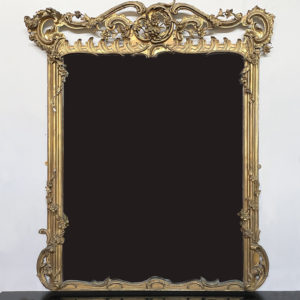
A spectacular Victorian gilt pine and composition overmantel mirror
£4,625A spectacular Victorian gilt pine and composition overmantel mirror
the rectangular plate surmounted with pierced carved rocaille work to the eared crestings ornamented with modelled floral tendrils that spiral down the uprights of the frame,£4,625 -

The environs of London in 1746. Impressive sixteen sheet set.
£4,500 the set of sixteen sheetsThe environs of London in 1746. Impressive sixteen sheet set.
John Rocque was of French Huguenot stock from Monosque in Provence. The London he eventually settled in, was an expanding city which had grown unchecked and by the 1730s a new map was needed. Harry Margary, a Senior Civil Scientific Engineer for the Admiralty and self-professed inventor, produced this full-size facsimile of the famous John Rocque map in 1971. The original 18th century map never joined properly due to paper shrinkage in the printing process and only the constituent copper plates joined. For this lithographically printed version Margary altered some of the edges so the maps would join and significantly cleaned up the image area.£4,500 the set of sixteen sheets -
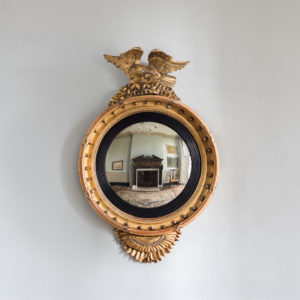
Regency gilded convex mirror
£3,250Regency gilded convex mirror
surmounted by cresting of an eagle perched and poised on rocks, the circular frame with balls and delicate lambrequin mould, a generous reeded and ebonised slip within and surrounding the original convex mirror-plate.£3,250 -
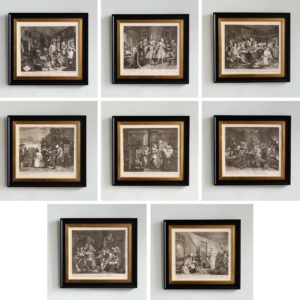
A Rake’s Progress after William Hogarth. A set of eight copper-engraved prints
£2,800 the set of eightA Rake’s Progress after William Hogarth. A set of eight copper-engraved prints
1803 Thomas Cook edition. Framed in black with a gold slip.£2,800 the set of eight -
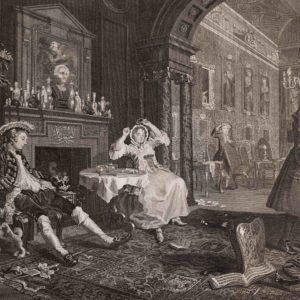
Marriage-a-la Mode, after William Hogarth. A set of six copper-engraved prints
£2,200 the set of sixMarriage-a-la Mode, after William Hogarth. A set of six copper-engraved prints
1803 Thomas Cook edition. Framed in black with a gold slip.£2,200 the set of six -

Nineteenth century gilt composition mirror
£1,750 -

Henri Matisse, Nu Bleu I
£1,750 eachHenri Matisse, Nu Bleu I
The foreword states: 'This double number of Verve is entirely dedicated to the last works of Matisse - 1950-1954. Reproduced in colour lithography, these works have been realised by the artist with papers coloured in gouache, cut with scissors and pasted. They are shown here with drawings executed at the same time or during the preceding period. Matisse composed the cover specially for this volume. These first lithographic plates were printed during the year 1954 under his direction. The printing of the lithographs in colour by Mourlot Frères and that of the photogravure reproductions and the typography by the master printers Draeger Frères, was completed in Paris on the 28th day of July 1958.'£1,750 each -

Henri Matisse, Nu Bleu II
£1,750 eachHenri Matisse, Nu Bleu II
The foreword states: 'This double number of Verve is entirely dedicated to the last works of Matisse - 1950-1954. Reproduced in colour lithography, these works have been realised by the artist with papers coloured in gouache, cut with scissors and pasted. They are shown here with drawings executed at the same time or during the preceding period. Matisse composed the cover specially for this volume. These first lithographic plates were printed during the year 1954 under his direction. The printing of the lithographs in colour by Mourlot Frères and that of the photogravure reproductions and the typography by the master printers Draeger Frères, was completed in Paris on the 28th day of July 1958.'£1,750 each -

Henri Matisse, Nu Bleu IV
£1,750 eachHenri Matisse, Nu Bleu IV
The foreword states: 'This double number of Verve is entirely dedicated to the last works of Matisse - 1950-1954. Reproduced in colour lithography, these works have been realised by the artist with papers coloured in gouache, cut with scissors and pasted. They are shown here with drawings executed at the same time or during the preceding period. Matisse composed the cover specially for this volume. These first lithographic plates were printed during the year 1954 under his direction. The printing of the lithographs in colour by Mourlot Frères and that of the photogravure reproductions and the typography by the master printers Draeger Frères, was completed in Paris on the 28th day of July 1958.'£1,750 each -

Henri Matisse, Nu Bleu X
£1,750 eachHenri Matisse, Nu Bleu X
The foreword states: 'This double number of Verve is entirely dedicated to the last works of Matisse - 1950-1954. Reproduced in colour lithography, these works have been realised by the artist with papers coloured in gouache, cut with scissors and pasted. They are shown here with drawings executed at the same time or during the preceding period. Matisse composed the cover specially for this volume. These first lithographic plates were printed during the year 1954 under his direction. The printing of the lithographs in colour by Mourlot Frères and that of the photogravure reproductions and the typography by the master printers Draeger Frères, was completed in Paris on the 28th day of July 1958.'£1,750 each -

Henri Matisse, Nu Bleu V
£1,750 eachHenri Matisse, Nu Bleu V
The foreword states: 'This double number of Verve is entirely dedicated to the last works of Matisse - 1950-1954. Reproduced in colour lithography, these works have been realised by the artist with papers coloured in gouache, cut with scissors and pasted. They are shown here with drawings executed at the same time or during the preceding period. Matisse composed the cover specially for this volume. These first lithographic plates were printed during the year 1954 under his direction. The printing of the lithographs in colour by Mourlot Frères and that of the photogravure reproductions and the typography by the master printers Draeger Frères, was completed in Paris on the 28th day of July 1958.'£1,750 each -

Henri Matisse, Nu Bleu VIII
£1,750 eachHenri Matisse, Nu Bleu VIII
The foreword states: 'This double number of Verve is entirely dedicated to the last works of Matisse - 1950-1954. Reproduced in colour lithography, these works have been realised by the artist with papers coloured in gouache, cut with scissors and pasted. They are shown here with drawings executed at the same time or during the preceding period. Matisse composed the cover specially for this volume. These first lithographic plates were printed during the year 1954 under his direction. The printing of the lithographs in colour by Mourlot Frères and that of the photogravure reproductions and the typography by the master printers Draeger Frères, was completed in Paris on the 28th day of July 1958.'£1,750 each -

Victorian Embroidered Royal Coat of Arms
£1,500Victorian Embroidered Royal Coat of Arms
19th century embroidered Coat of Arms presented in a maple frame with gilt slip.£1,500 -
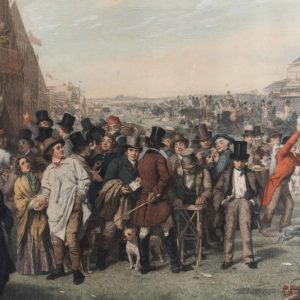
William Powell Frith ‘The Derby Day’
£1,450 -

The Caravan
£1,400The Caravan
The Caravan Signed and dated 'George Charlton 1935' A Gypsy caravan shown shaded by the boughs of two Elm trees on Hampstead Heath. The painter George Charlton was born in London in 1899. He studied at the Slade School of Fine Art from 1914 before joining the staff in 1919. He later taught at the Willesden School of Art from 1949–59 and was an examiner in art for the University of London for many years. Showed widely in London he achieved his first one-man show at Cork Street's Redfern Gallery in 1924 before exhibiting solo at the avant-garde Beaux Arts Gallery on Bruton Place. His work is held by the Tate Gallery in London.£1,400 -

Cary’s New Plan of London and it’s Vicinity 1838
£1,400Cary’s New Plan of London and it’s Vicinity 1838
Detailed map with original hand-colour showing the limits of the two penny postal delivery service. Framed£1,400 -

Early nineteenth century gilt framed pier mirror,
£1,250Early nineteenth century gilt framed pier mirror,
with coloured engraving after 'Shipwreck' by Peter Monamy (1681 - 1749) set above the original plate.£1,250 -

Pub at Cerne Abbas
£1,250Pub at Cerne Abbas
A British inter-war watercolor and ink portrait of the stable yard of the 16th-century New Inn in Cerne Abbas, Dorset. George Charlton was born in London in 1899. He studied at the Slade School of Fine Art from 1914 before joining the staff in 1919. He later taught at the Willesden School of Art from 1949–59 and was an examiner in art for the University of London for many years. Showed widely in London he achieved his first one-man show at Cork Street's Redfern Gallery in 1924 before exhibiting solo at the avant-garde Beaux Arts Gallery on Bruton Place. His work is held by the Tate Gallery in London.£1,250 -

Eagle Wharf, Whistler
£1,200Eagle Wharf, Whistler
A framed black-line etching by the American artist and engraver James MacNeil Whistler showing shipping off Eagle Wharf off Wapping in the Pool of London. Taken from 'A Series of Sixteen Etchings of Scenes on the Thames and Other Subjects', otherwise referred to as The Thames Set, the pictures were created over a period of 12 years starting in 1859 and finally published as a complete set by Ellis & Green in London in 1871.£1,200 -

The Dance, by Henri Matisse, Jan – March 1939 / No. 4.
£1,200The Dance, by Henri Matisse, Jan – March 1939 / No. 4.
The Verve Review was a purposefully luxurious. It ran from 1937 to 1960, but with only 38 editions available, due to the high degree of design and editorial work dedicated to each issue. Each edition contained unique lithographic prints, commissioned by the editor, and each cover a double-page lithograph elaborated by one of the artists contained within. It was the brainchild of its editor Stratis Eleftheriades, a Greek National who moved to Paris in the early thirties to take part in the growing Modernist movement, writing under the name of Teriade.£1,200 -
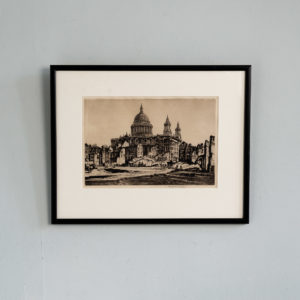
Henry Rushbury, St. Pauls from the North,
£1,200Henry Rushbury, St. Pauls from the North,
A signed and dated, framed and mounted drypoint engraving by Sir Henry Rushbury showing St Pauls Cathedral viewed over the bomb damaged remnant of what was Paternoster Row and London's printing district after the 'Worst Raid' of the London Blitz on the 10-11th of May 1941. First exhibited at the Royal Academy, Summer Exhibition in 1944, the print is one of a series by Sir Henry documenting the destruction of London landmarks during the Second World War.£1,200 -

A Lazy Day in the Farmyard
£1,200A Lazy Day in the Farmyard
A study in pencil, black ink and watercolour of a rustic farmyard scene by the artist and painter George Charlton. George Charlton was born in London in 1899. He studied at the Slade School of Fine Art from 1914 before joining the staff in 1919. He later taught at the Willesden School of Art from 1949–59 and was an examiner in art for the University of London for many years. Showed widely in London he achieved his first one-man show at Cork Street's Redfern Gallery in 1924 before exhibiting solo at the avant-garde Beaux Arts Gallery on Bruton Place. His work is held by the Tate Gallery in London.£1,200 -

Cattle Drinking, George Charlton
£975Cattle Drinking, George Charlton
A farmyard scene by the artist George Charlton. The painter George Charlton was born in London in 1899. He studied at the Slade School of Fine Art from 1914 before joining the staff in 1919. He later taught at the Willesden School of Art from 1949–59 and was an examiner in art for the University of London for many years. Showed widely in London he achieved his first one-man show at Cork Street's Redfern Gallery in 1924 before exhibiting solo at the avant-garde Beaux Arts Gallery on Bruton Place. His work is held by the Tate Gallery in London.£975 -

The Collector by Dan Hillier (1973-2024)
£950The Collector by Dan Hillier (1973-2024)
Dan Hillier captured the zeitgeist of the early noughties with his collages that combined Victorian source materials with human, animal, and arcane elements into mysterious surreal art works. Born in Oxfordshire he went on to study Illustration and Graphic Arts at Anglia Ruskin University in Cambridge, later living and working in Stoke Newington, London. Beginning to sell his prints from a market stall in East London he eventually attracting the attention of prestigious gallerists and commercial collaborators like Shakespeare’s Globe, Marc Jacobs, Louis Vuitton and the National Theatre. Dan's distinctive art graced the opening titles of the 2018 BBC drama series Requiem. He moved to Dartmoor in 2022 to be closer to his family and nature but sadly, Dan Hillier passed away in 2024 following a short illness.£950 -

Middlesex by R.W. Seale, c1760
£950Middlesex by R.W. Seale, c1760
Title: 'To the Most Noble / Thomas Holles Pelham / Duke of NEWCASTLE. / Lord Lieutenant of Middlesex & Westminster, His Majesty's / Principal Secretary of State, Chancellor of the University / of Cambridge, & Knight of the Most Noble Order of y e GARTER. / This MAP of the COUNTY of MIDDLESEX / is Dedicated by his grace's most humble Servant / R.W. Seale.£950 -

Henri Matisse, ‘The Last Works of Henri Matisse’
£900 eachHenri Matisse, ‘The Last Works of Henri Matisse’
From Verve Vol. IX No. 35/36 published by Tériade under the title 'The Last Works of Henri Matisse'£900 each -

George Charlton Self Portrait
£900George Charlton Self Portrait
An early pencil self portrait by the artist George Charlton. The painter George Charlton was born in London in 1899. He studied at the Slade School of Fine Art from 1914 before joining the staff in 1919. He later taught at the Willesden School of Art from 1949–59 and was an examiner in art for the University of London for many years. Showed widely in London he achieved his first one-man show at Cork Street's Redfern Gallery in 1924 before exhibiting solo at the avant-garde Beaux Arts Gallery on Bruton Place. His work is held by the Tate Gallery in London.£900 -

Ramsgate Sands by William Powell Frith
£900Ramsgate Sands by William Powell Frith
Original steel engraving published 1854. Presented in a gilt frame with lower margin title, trimmed to the image area£900 -

The Strand, William Walcot
£850The Strand, William Walcot
Framed and mounted black line etching by the artist-engraver William Walcot showing the The Strand during the construction of the Aldwych in 1924. Issued as part of Walcot's London Set at the height of his success.£850 -

The Army and Navy Nelson & Wellington,
£850The Army and Navy Nelson & Wellington,
A hand coloured engraving By S.W. Reynolds after a painting by John Prescott Knight showing the only meeting between Arthur Wellesley Duke of Wellington and Admiral Lord Horatio Nelson, which took place in September, 1805 at the Colonial Office on Downing Street in London.£850 -

A General Prospect of Vaux Hall Gardens. Shewing at one View the disposition of the whole Gardens. Vüe Détaillee des Jardins de Vaux Hall.
£850A General Prospect of Vaux Hall Gardens. Shewing at one View the disposition of the whole Gardens. Vüe Détaillee des Jardins de Vaux Hall.
Originally engraved by William Simpkins (fl.1784-1825) for Owen Manning and William Bray’s “History and Antiquities of Surrey” (1804-1814).£850 -

W. L Wylie R. A., Old Waterloo Bridge from the South Bank,
£850W. L Wylie R. A., Old Waterloo Bridge from the South Bank,
An original dry-point engraving by British marine artist, painter etcher and illustrator W. L. Wyllie (1851-1931) showing Old Waterloo Bridge from the Surrey shore with three steam Toshers working on the Lambeth Reach of the River Thames. Mounted and in its original frame. Old Waterloo bridge, designed and built by the engineer John Rennie was built in 1827 and stood until 1924 when the increased scour of the river, caused by the removal of the many-piered Old London Bridge, made necessary its dismantling and replacement. Signed by the artist in pencil in he margin.£850 -

W. L Wylie R. A., Sugar boats Greenwich Reach,
£850W. L Wylie R. A., Sugar boats Greenwich Reach,
An original dry-point engraving by British marine artist, painter etcher and illustrator W. L. Wyllie (1851-1931). Signed in pencil by the artist "A view of Greenwich from the Isle of Dogs (i.e. the north-west) with figures, probably local boys, swimming off the beach in the foreground around a small lighter. The Royal Naval College is to the left and the Royal Observatory high in the background above the Park and the riverside town centre of Greenwich proper. In the centre cargo ships are unloading sugar into lighters alongside, in the deep-water mooring tier between Greenwich and Deptford. The atmosphere beyond over the shoreline is one of industrial haze through which a Thames barge, chimneys and a crane can be seen. Astern of the ships small steamers cluster off Greenwich Pier." National Maritime Museum listing.£850 -

The Reconstruction of Piccadilly, William Walcot
£840The Reconstruction of Piccadilly, William Walcot
Framed and mounted black line etching by the artist-engraver William Walcot showing the rebuilding of Picadilly Circus and the Swan and Edgar building following destruction by Zeppelin raid in 1917. Issued as part of Walcot's London Set in 1924.£840 -

Portrait by Andre Derain, Verve Vol 2 / No. 5-6.
£800Portrait by Andre Derain, Verve Vol 2 / No. 5-6.
The Verve Review was a purposefully luxurious. It ran from 1937 to 1960, but with only 38 editions available, due to the high degree of design and editorial work dedicated to each issue. Each edition contained unique lithographic prints, commissioned by the editor, and each cover a double-page lithograph elaborated by one of the artists contained within. It was the brainchild of its editor Stratis Eleftheriades, a Greek National who moved to Paris in the early thirties to take part in the growing Modernist movement, writing under the name of Teriade.£800 -

Head of a Girl by George Rouault, Verve Vol 2 / No. 5-6.
£800Head of a Girl by George Rouault, Verve Vol 2 / No. 5-6.
The Verve Review was a purposefully luxurious. It ran from 1937 to 1960, but with only 38 editions available, due to the high degree of design and editorial work dedicated to each issue. Each edition contained unique lithographic prints, commissioned by the editor, and each cover a double-page lithograph elaborated by one of the artists contained within. It was the brainchild of its editor Stratis Eleftheriades, a Greek National who moved to Paris in the early thirties to take part in the growing Modernist movement, writing under the name of Teriade.£800 -

Stars by Wassily Kandinsky, Verve Vol. 1 / No. 2.
£800Stars by Wassily Kandinsky, Verve Vol. 1 / No. 2.
The Verve Review was a purposefully luxurious. It ran from 1937 to 1960, but with only 38 editions available, due to the high degree of design and editorial work dedicated to each issue. Each edition contained unique lithographic prints, commissioned by the editor, and each cover a double-page lithograph elaborated by one of the artists contained within. It was the brainchild of its editor Stratis Eleftheriades, a Greek National who moved to Paris in the early thirties to take part in the growing Modernist movement, writing under the name of Teriade.£800 -

Comets by Wassily Kandinsky, Verve Vol. 1 / No. 2.
£800Comets by Wassily Kandinsky, Verve Vol. 1 / No. 2.
The Verve Review was a purposefully luxurious. It ran from 1937 to 1960, but with only 38 editions available, due to the high degree of design and editorial work dedicated to each issue. Each edition contained unique lithographic prints, commissioned by the editor, and each cover a double-page lithograph elaborated by one of the artists contained within. It was the brainchild of its editor Stratis Eleftheriades, a Greek National who moved to Paris in the early thirties to take part in the growing Modernist movement, writing under the name of Teriade.£800 -
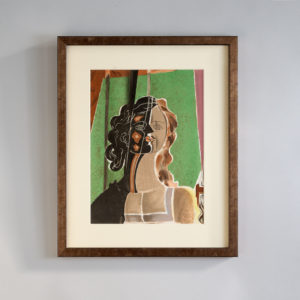
Figure by Georges Braque, Verve Vol 2 / No. 5-6.
£800Figure by Georges Braque, Verve Vol 2 / No. 5-6.
The Verve Review was a purposefully luxurious. It ran from 1937 to 1960, but with only 38 editions available, due to the high degree of design and editorial work dedicated to each issue. Each edition contained unique lithographic prints, commissioned by the editor, and each cover a double-page lithograph elaborated by one of the artists contained within. It was the brainchild of its editor Stratis Eleftheriades, a Greek National who moved to Paris in the early thirties to take part in the growing Modernist movement, writing under the name of Teriade.£800 -
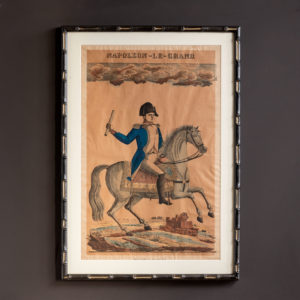
Napoleon-Le-Grand
£800Napoleon-Le-Grand
Jean-Charles Pellerin (1756 - 1836) was a French illustrator, artist, and printer. Born in Epinal, France.£800 -
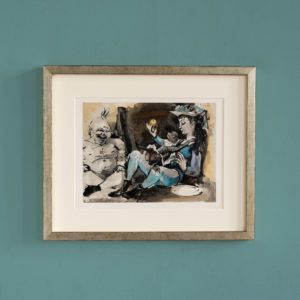
Picasso and the Human Comedy, Verve, Vol. VIII, No 29/30, 1954
£795 eachPicasso and the Human Comedy, Verve, Vol. VIII, No 29/30, 1954
Original lithograph print from Verve Vol. VIII, No 29/30 printed by the Master Printers Mourlot Frères in 1954. Framed in champagne gold with a cream mount.£795 each -

Picasso and the Human Comedy, Verve, Vol. VIII, No 29/30, 1954
£795 eachPicasso and the Human Comedy, Verve, Vol. VIII, No 29/30, 1954
Original lithograph print from Verve Vol. VIII, No 29/30 printed by the Master Printers Mourlot Frères in 1954. Framed in champagne gold with a cream mount.£795 each -

Picasso and the Human Comedy, Verve, Vol. VIII, No 29/30, 1954
£795 eachPicasso and the Human Comedy, Verve, Vol. VIII, No 29/30, 1954
Original lithograph print from Verve Vol. VIII, No 29/30 printed by the Master Printers Mourlot Frères in 1954. Framed in champagne gold with a cream mount.£795 each -

Picasso and the Human Comedy, Verve, Vol. VIII, No 29/30, 1954
£795 eachPicasso and the Human Comedy, Verve, Vol. VIII, No 29/30, 1954
Original lithograph print from Verve Vol. VIII, No 29/30 printed by the Master Printers Mourlot Frères in 1954. Framed in champagne gold with a cream mount.£795 each -

Picasso and the Human Comedy, Verve, Vol. VIII, No 29/30, 1954
£795 eachPicasso and the Human Comedy, Verve, Vol. VIII, No 29/30, 1954
Original lithograph print from Verve Vol. VIII, No 29/30 printed by the Master Printers Mourlot Frères in 1954. Framed in champagne gold with a cream mount.£795 each -

Picasso and the Human Comedy, Verve, Vol. VIII, No 29/30, 1954
£795 eachPicasso and the Human Comedy, Verve, Vol. VIII, No 29/30, 1954
Original lithograph print from Verve Vol. VIII, No 29/30 printed by the Master Printers Mourlot Frères in 1954. Framed in champagne gold with a cream mount.£795 each -

Picasso and the Human Comedy, Verve, Vol. VIII, No 29/30, 1954
£795 eachPicasso and the Human Comedy, Verve, Vol. VIII, No 29/30, 1954
Original lithograph print from Verve Vol. VIII, No 29/30 printed by the Master Printers Mourlot Frères in 1954. Framed in champagne gold with a cream mount.£795 each -

Picasso and the Human Comedy, Verve, Vol. VIII, No 29/30, 1954
£795 eachPicasso and the Human Comedy, Verve, Vol. VIII, No 29/30, 1954
Original lithograph print from Verve Vol. VIII, No 29/30 printed by the Master Printers Mourlot Frères in 1954. Framed in champagne gold with a cream mount.£795 each -

Early nineteenth century nude study,
£750Early nineteenth century nude study,
An early nineteenth century framed charcoal life-study of a male figure. The figure is shown heroically nude, from the front, in a full length, slightly serpentina pose with the right arm radiating from the torso. The composition is depicted contraposto and leaning on a spear or staff. The pose depicted is shows a slightly adapted and altered rendering of the famous Doryphorus, or Spear-Barer of Polykleitos. Polykleitos was known as the best sculptor of men in the ancient world, with the primary subjects of his works being male athletes with idealised body proportions. He was interested most chiefly in the mathematical proportions of the human form, which led him to write an essay the famous Kanon, on the proportions of humans. The Doryphoros is an illustration of his writings in Kanon on the symmetry between the body parts£750 -

Early nineteenth century nude study,
£750Early nineteenth century nude study,
An early nineteenth century framed charcoal life-study of a female figure. The figure, shown side-on, models the Pudica pose, an affected posture of chaste virtue, inherited from classical art.£750 -

Early nineteenth century nude study,
£750Early nineteenth century nude study,
An early nineteenth century framed charcoal life-study of a male figure. The figure is shown heroically nude, from the front, in a full length, adlocutio pose, contraposto and grasping a shaft or baton. The pose is a famous one in Classical Art, said to embody power, control and leadership, and its most famous example is the Augusto di Prima Porta in the Vatican Museums in Rome.£750 -

Early nineteenth century nude study,
£750Early nineteenth century nude study,
An early nineteenth century framed charcoal life-study of a male figure. The figure is shown from behind in full length, contraposto, with developed musculature and a sinuous, dramatic, figura serpentina recollecting the Dancing Faun of the Uffizi, and the famous Farnese Hercules.£750 -

The Battle at La Hogue
£750The Battle at La Hogue
A large framed and mounted black line engraving by William Wollett afer the painting by Benjamin West showing the Anglo-Dutch naval victory at La Hogue off the coast of Normandy in 1692. " Standing in a boat at the left ... Vice Admiral George Rooke embodies heroic command with his upright posture and raised sword... Beached in the center distance is the French flagship, the Royal Sun. Actually burned and sunk a few days before this encounter, the Royal Sun is here deliberately refloated -- only to be run against the cliffs so that West might symbolize the French defeat." U.S. National Gallery of Art, Washington D.C.£750 -

Nathaniel Sparks, The Clock Tower, St. Pauls,
£750Nathaniel Sparks, The Clock Tower, St. Pauls,
Mounted and in its original frame, an original dry-point engraving by the artist and painter-etcher Nathaniel Sparks showing the Clock Tower of St Paul's Cathedral viewed from Carter Lane. The first clock was inserted into the Great West Portico of St Paul's by Smith of Derby in 1893 and is still maintained by them to this day. Signed by the artist on the plate. Presented in a black frame with a cream mount.£750 -
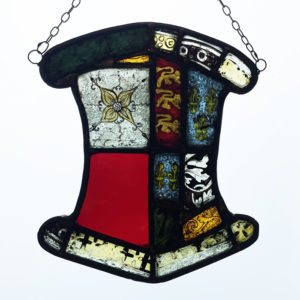
An English leaded stained glass hanger,
£745An English leaded stained glass hanger,
a cartouche-shaped light incorporating old fragments (some probably medieval): with three lions on a red ground and fleur-de-lys on blue, chain hung from wire loops,£745 -

Our Fathers, To The Memory of the Nameless Killed and Wounded
£725 the pairOur Fathers, To The Memory of the Nameless Killed and Wounded
A set of four etchings in two frames depicting ships of war and life at sea in English history By William Wylie and accompanied by the words of Cpt. Ronald Hopwood's poem Our Fathers. William Lionel Wylie was the most distinguished marine artist of the late nineteenth and early twentieth centuries. He became almost a painter laureate to the Royal Navy, so much so that during his funeral, in a scene reminiscent of Nelson's state funeral in 1806, his body was rowed up Portsmouth Harbour in a naval cutter past battleships with dipped colours and bugles calling and quaysides lined with dockyard workers. Similarly Captain Ronald A Hopwood was described as the poet laureate of the Royal Navy by Time Magazine in 1941. His most enduring work, The Laws of the Navy, became and remains a sort of Works and Days primer for naval life, both inspiring and edifying seamen in the ways of the senior service. After the Battle of Jutland in 1916 when the press was critical of an apparent failure by the Royal Navy to achieve a clear victory against the Imperial German Navy the Times of London published The Old Ways, a poem by Hopwood and within this was a further poem, Our Fathers which was first written during the naval manoeuvres of 1913. Wyllie, we are told, was much taken with the verses and he arranged to illustrate them with the agreement of their author as a memorial of sorts to the dead (and perhaps as an apologia for the living) of the Battle of Jutland. The seaplane depicted appears to be a short type 184 used at Gallipoli where it became the first aircraft in the world to attack an enemy ship with an air-launched torpedo. The Battleship in the next image is of the King George V class and likely to be based on HMS Audacious, which Wylie had studied previously. The poem and illustrative etchings then go back in time to the navy of Elizabeth I's time. The sailing ships depicted are galleons of the type which chased the Spanish Armada out of the channel, a scene depicted at the bottom of the first print. The second framed picture depicts naval exercises and gunnery practice, with a galleon being scraped and caulked by hand on a secluded beach in the Spanish Main. It concludes with a scene of high-technology Super-Dreadnoughts of the Queen Elizabeth class - a naval nominative choice which perhaps inspires the scheme of the whole work of reflection.£725 the pair -

Steeple of St Mary-Le-Bow, Cheapside
£700Steeple of St Mary-Le-Bow, Cheapside
Pre-war pen and ink drawing showing the Steeple of St Mary-Le-Bow on Cheapside in the City of London. Signed by the artist.£700 -

Set of Indian orthniological paintings on mica
£660 set of sixSet of Indian orthniological paintings on mica
Mica is a transparent mineral composed of complex mixtures of potassium silicates. The variety of mica used most frequently by these Indian artists is Muscovite (H2KAl3 Si04)3 which is found widely throughout south India. The mica is formed between strata of granite and the transparency of the material is a result of the heat and pressure created between the layers of rock during formation. Mica consists of many interlocking platelets, resulting in a laminar structure which can be split easily into thin sheets.£660 set of six -
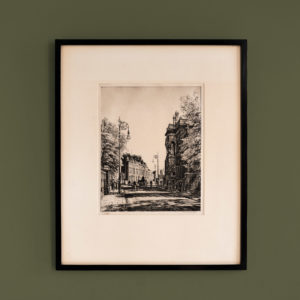
Poplar
£650Poplar
An original framed and mounted dry-point engraving by the artist engraver Frances Dodd RA showing Poplar Old Town hall on Newby Place in 1930. Hand signed in pencil by the artist.£650 -

St. James’s Church Clerkenwell
£650St. James’s Church Clerkenwell
A framed and mounted black line etching by the English artist Sir Henry Rushbury KCVO CBE RA (28 October 1889 – 5 July 1968) depicting St James's Church Clerkenwell. Signed in pencil by the artist. Clerkenwell contained a notorious slum at the turn of the 20h Century and was the setting for George Gissing's Novel, The Netherworld - "Opposite, the shapes of poverty-eaten houses and grimy workshops stood huddling in the obscurity. From near at hand came shrill voices of children chasing each other about – children playing at midnight between slum and gaol!"£650 -

Lambeth Bridge With Shipping
£650Lambeth Bridge With Shipping
Pedestrians idle on the parapet of Old Lambeth Bridge while a steam tug passes beneath the central arch towing a Thames barge. Warehouses, wharves and houses line the Westminster shore. A Framed and mounted mixed media sketch by the artist Hubert Williams showing Old Lambeth Bridge prior to it's demolition in 1928. Signed on the plate by the artist.£650 -

Watercolour of South Kensington Station
£650Watercolour of South Kensington Station
Framed watercolour of South Kensington underground station, painted in the mid 1920's. Captured from a window of No.1 Old Brompton Road, the viewer is shown the view looking east over the station roof and down Pelham Street towards Brompton Cross. The scene shows a winter's day with passengers climbing aboard the upper deck of K-Type Omnibus.£650 -

St. Paul’s Cathedral from Cannon Street
£625St. Paul’s Cathedral from Cannon Street
A famed drypoint engraving of a bomb-damaged St Pauls viewed from Cannon Street dated 1942 by the War Artist Sir Henry Rushbury KCVO CBE RA (28 October 1889 – 5 July 1968). Signed and dated by the artist.£625 -

Japanese Woodblock Diptych.
£600 -

Pair of 19th Century Traditional Chinese Figure Paintings.
£600 the pairPair of 19th Century Traditional Chinese Figure Paintings.
Chinese pith paintings came into use for painting to satisfy the increasing demand for small, inexpensive and easily transported souvenirs, following the massive growth in the China Trade in the first quarter of the nineteenth century. Because of the nature of pith and its cellular structure, the gouache used by the Chinese sat on the surface and produced a bright and even sparkling effect.£600 the pair -

Portrait Fragment by Pierre Bonnard, Verve Vol 2 / No. 5-6.
£600Portrait Fragment by Pierre Bonnard, Verve Vol 2 / No. 5-6.
The Verve Review was a purposefully luxurious. It ran from 1937 to 1960, but with only 38 editions available, due to the high degree of design and editorial work dedicated to each issue. Each edition contained unique lithographic prints, commissioned by the editor, and each cover a double-page lithograph elaborated by one of the artists contained within. It was the brainchild of its editor Stratis Eleftheriades, a Greek National who moved to Paris in the early thirties to take part in the growing Modernist movement, writing under the name of Teriade.£600 -
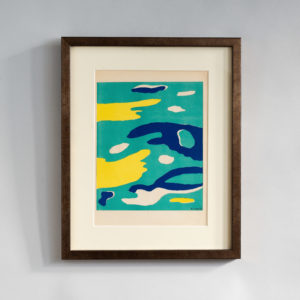
The Four Elements, Water by Fernand Leger, Verve Vol. 1 / No. 1.
£600The Four Elements, Water by Fernand Leger, Verve Vol. 1 / No. 1.
The Verve Review was a purposefully luxurious. It ran from 1937 to 1960, but with only 38 editions available, due to the high degree of design and editorial work dedicated to each issue. Each edition contained unique lithographic prints, commissioned by the editor, and each cover a double-page lithograph elaborated by one of the artists contained within. It was the brainchild of its editor Stratis Eleftheriades, a Greek National who moved to Paris in the early thirties to take part in the growing Modernist movement, writing under the name of Teriade.£600 -

The Moon by André Masson, Verve Vol. 1 / No. 2.
£600The Moon by André Masson, Verve Vol. 1 / No. 2.
The Verve Review was a purposefully luxurious. It ran from 1937 to 1960, but with only 38 editions available, due to the high degree of design and editorial work dedicated to each issue. Each edition contained unique lithographic prints, commissioned by the editor, and each cover a double-page lithograph elaborated by one of the artists contained within. It was the brainchild of its editor Stratis Eleftheriades, a Greek National who moved to Paris in the early thirties to take part in the growing Modernist movement, writing under the name of Teriade.£600 -
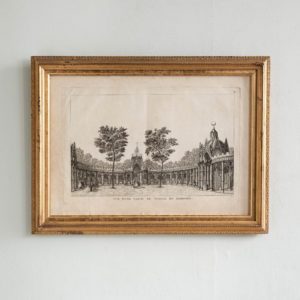
Vue D’une partie du Voxhal de Londres
£600Vue D’une partie du Voxhal de Londres
The Temple of Comus was named… after the god of cheer and good food. The building, which, although primarily devoted to dining, allowed for the appreciation of the arts and music as well as polite conversation in civilised surroundings. Initially, the building was “classical in style, with a colonnade of Ionic columns supporting a straight entablature, topped with urn finials; the semicircle flowed in a smooth curve out of the straight colonnade of the northern range of supper-boxes.” However, the designer also incorporated Gothic arches and “broad-ramped scrolls that acted as buttresses for the dome” and other unorthodox details. “The apparent breaking of architectural rules, mingling different styles in the same building, was deliberate and entirely typical of the unorthodox design of the English Rococo, which aimed to create playful, light-hearted works.”
£600 -
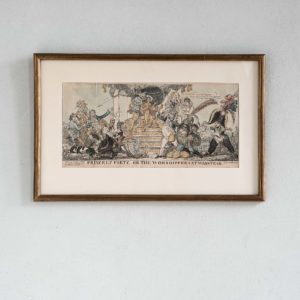
Princely Piety, or the worshippers at Wanstead,
£595Princely Piety, or the worshippers at Wanstead,
A hand-coloured etching by the caricaturist George Cruikshank depicting the wooing of a wealthy young heiress by a cast of reprobate suitors. Upon the death of her only brother James at the age of 11 in 1805 Catherine Tylney-Long became the richest commoner in England in her own right. At the tender of of 16 the 'Wiltshire Heiress' had come into a fortune of nearly £30,000,000 in today's money. This made the poor girl a prime target for every fortune hunter and indebted rake in England who wished to clear his creditors. The law as it stood in the early 19th Century had degenerated to such a degree that, under the principle of coverture, it denied a married woman any property at all in her own right while her legal existence as a feme covert was entirely subsumed in that of her husband. This left the wealthy orphan daughter of Sir James Tylney long, 7th Baronet in a difficult and precarious position, caught between the social stigma attached to unmarried womanhood and the appeals of a host of insinuating cads seeking her hand in marriage. Here Cruikshank depicts the many and assorted indigent suitors for the hand of the wealthy heiress. To the left of the dais are shown Lord Kilworth and William Wesley-Pole, later 4th Earl of Mornington a dissipated Anglo-Irish nobleman, who dueled over the courtship of Catherine. Kneeling at the foot of the steps we may also see the figure of Romeo Coates, unintentionally comic actor and 'improver' of Shakespeare included apparently 'not because of his pretensions, but his boasts and wishes'. Above him we see the fop and jobbing playwright, Sir Lumley Skeffington laying his poetic efforts at the feet of the heiress. On the right hand we see The Duke of Clarence, later William IV who by this point had debts of many hundreds of thousands of pounds holding back Baron-de-Geramb, a Spanish military adventurer and suspected Napoleonic spy who later became a Trappist monk where he used his position as procurator-general of that ancient order to defray his personal expenses. Above the Duke we see reproving the figure of Mrs Jordan, his 'common-law' wife with whom he had fathered many children at his retreat of Bushey Park. The farcical presentation of the situation belies it's tragic outcome. Perhaps cajoled by just such unkind insinuations as are repeated in this caricature Catherine would choose the worst-of-the-bunch, William Wesley-Pole, as her preferred suitor. William Wesley-Pole-Tylney-Long, as he became by Royal Licence in 1812, was an unredeemed rake and not only abused and impoverished his saintly young wife but also passed her a debilitating infection and caused her family seat at Wanstead House to be demolished and sold for salvage. After a short and unhappy marriage Catherine died at the age of only 35 after receiving a final brutal letter from her estranged husband, the contents of which apparently caused her to have some form of seizure. Frustrated in his efforts to gain custody of their son William, on whom the family fortune had devolved, William Pole Tylney-Long-Wellesley, 4th Earl of Mornington (the final name by which he was known) died in 1857 unwept, unhonoured and unsung if also unrepentant. His obituary in the Morning Star described him as "A spendthrift, a profligate, and a gambler in his youth, he became debauched in his manhood... redeemed by no single virtue, adorned by no single grace, his life gone out even without a flicker of repentance".£595 -

Black Hill, by Gordon House
£575 eachBlack Hill, by Gordon House
Gordon House was a graphic designer and abstract painter. He went to art school in Luton, then later, won a scholarship to St. Albans. During the 1950’s he spent much time in Letchworth, Welwyn and working for Imperial Chemical Industries (ICI) becoming aware of a modernist style of graphics through the design of European pharmaceutical packaging. This style was new to British eyes at the time and he went on to design the graphics for many galleries during the 1960’s. Mixing in new circles he collaborated with leading artists like Peter Blake and Richard Hamilton. He was responsible for the white on white emboss of the band’s name across the record sleeve on the Beatles White album against the wishes of Hamilton, who wanted to leave the sleeves totally blank, save for the stamp of a unique issue number. The Tate Gallery holds more than 100 of his prints and his work is also represented in many important public collections including the Arts Council, the British Council, the Victoria & Albert Museum and the M.O.M.A. in New York.£575 each -

Black Hill, Pages, by Gordon House
£575 eachBlack Hill, Pages, by Gordon House
Gordon House was a graphic designer and abstract painter. He went to art school in Luton, then later, won a scholarship to St. Albans. During the 1950’s he spent much time in Letchworth, Welwyn and working for Imperial Chemical Industries (ICI) becoming aware of a modernist style of graphics through the design of European pharmaceutical packaging. This style was new to British eyes at the time and he went on to design the graphics for many galleries during the 1960’s. Mixing in new circles he collaborated with leading artists like Peter Blake and Richard Hamilton. He was responsible for the white on white emboss of the band’s name across the record sleeve on the Beatles White album against the wishes of Hamilton, who wanted to leave the sleeves totally blank, save for the stamp of a unique issue number. The Tate Gallery holds more than 100 of his prints and his work is also represented in many important public collections including the Arts Council, the British Council, the Victoria & Albert Museum and the M.O.M.A. in New York.£575 each -

Black Hill, Rostra, by Gordon House
£575 eachBlack Hill, Rostra, by Gordon House
Gordon House was a graphic designer and abstract painter. He went to art school in Luton, then later, won a scholarship to St. Albans. During the 1950’s he spent much time in Letchworth, Welwyn and working for Imperial Chemical Industries (ICI) becoming aware of a modernist style of graphics through the design of European pharmaceutical packaging. This style was new to British eyes at the time and he went on to design the graphics for many galleries during the 1960’s. Mixing in new circles he collaborated with leading artists like Peter Blake and Richard Hamilton. He was responsible for the white on white emboss of the band’s name across the record sleeve on the Beatles White album against the wishes of Hamilton, who wanted to leave the sleeves totally blank, save for the stamp of a unique issue number. The Tate Gallery holds more than 100 of his prints and his work is also represented in many important public collections including the Arts Council, the British Council, the Victoria & Albert Museum and the M.O.M.A. in New York.£575 each -

Black Hill, Work Shop, by Gordon House
£575 eachBlack Hill, Work Shop, by Gordon House
Gordon House was a graphic designer and abstract painter. He went to art school in Luton, then later, won a scholarship to St. Albans. During the 1950’s he spent much time in Letchworth, Welwyn and working for Imperial Chemical Industries (ICI) becoming aware of a modernist style of graphics through the design of European pharmaceutical packaging. This style was new to British eyes at the time and he went on to design the graphics for many galleries during the 1960’s. Mixing in new circles he collaborated with leading artists like Peter Blake and Richard Hamilton. He was responsible for the white on white emboss of the band’s name across the record sleeve on the Beatles White album against the wishes of Hamilton, who wanted to leave the sleeves totally blank, save for the stamp of a unique issue number. The Tate Gallery holds more than 100 of his prints and his work is also represented in many important public collections including the Arts Council, the British Council, the Victoria & Albert Museum and the M.O.M.A. in New York.£575 each -
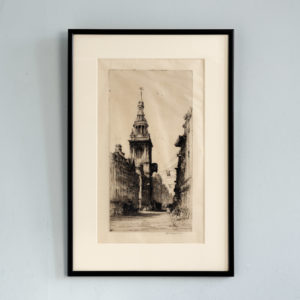
Nathaniel Sparks, St Mary-le-Bow, Cheapside,
£570Nathaniel Sparks, St Mary-le-Bow, Cheapside,
An original dry-point engraving by the artist and painter-etcher Nathaniel Sparks showing the steeple of St Mary le Bow viewed looking west up Cheapside. Signed by the artist. Presented in a cream mount and black frame.£570 -

Pablo Picasso, Lithograph based on Edouard Manet’s, Luncheon on the the Grass. c1962
£550Pablo Picasso, Lithograph based on Edouard Manet’s, Luncheon on the the Grass. c1962
From 1959-1962 Pablo Picasso and his second wife Jacqueline lived at Château de Vauvenargues near Aix-en-Provence. He spent most of his time of his time on 140 drawings and 27 paintings, lino-cuts and cardboard models all on the theme of Manet’s, Le Déjeuner sur l’herbe. Manet's original painting from 1862 showing a nude woman sitting between two fully clothed men was a scandal for the time.£550 -

Leigh on Sea, Albert Houghton
£550Leigh on Sea, Albert Houghton
Mounted and framed watercolour painting by the English artist and painter, Albert Houghton showing fishing boats at Leigh on Sea, Essex. 1970, signed by the artist.£550 -

Buildings & Boats
£550Buildings & Boats
A framed and mounted black line etching by the artist-engraver Norman Jones RWS RE RSMA, showing a riverside wharf scene in the Lower Pool of the River Thames, possibly corresponding to the river frontage of Narrow Street, Limehouse. Signed in pencil by the artist.£550 -
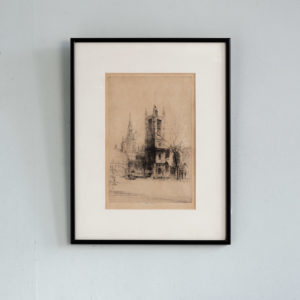
Frederick Farrell, St. Margarets Church, Westminster,
£550Frederick Farrell, St. Margarets Church, Westminster,
A framed and mounted original etching by Frederick Arthur Farrell depicting St Margaret's Church Westminster from across Parliament Square. Hand signed by the artist in pencil.£550 -

Charles Watson, Chelsea
£550Charles Watson, Chelsea
A framed and mounted etching by the English artist Charles Watson (1846-1927) depicting the foreshore at Chelsea with two barges at low tide. In the distance is shown the tower of Chelsea Old Church and a part of Old Battersea Bridge, replaced in 1890. The vantage is from close to the current site of the Chelsea Yacht and Boat Yard. Signed on the plate.£550 -
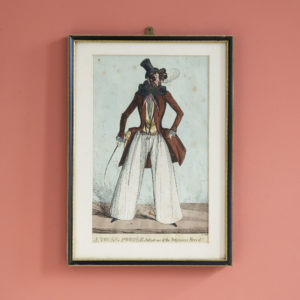
‘A Young Poodle, but not one of the Sagacious Breed’
£520‘A Young Poodle, but not one of the Sagacious Breed’
Caricaturist, presumably of Irish background, but undocumented. Responsible for a small number of plates in a distinctive hand. Unclear whether he etched them all or only designed them. Never a publisher. Worked for P.Roberts and J.Aitken. Many unsigned prints by both men may well be by him.£520 -
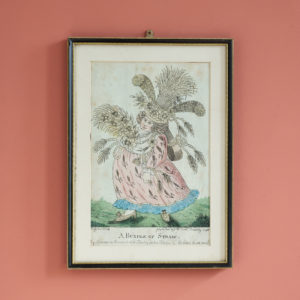
A Bundle of Straw, My Spouse is Remarkable Tasty in his Dress & he likes to see me so.
£520A Bundle of Straw, My Spouse is Remarkable Tasty in his Dress & he likes to see me so.
Caricaturist, presumably of Irish background, but undocumented. Responsible for a small number of plates in a distinctive hand. Unclear whether he etched them all or only designed them. Never a publisher. Worked for P.Roberts and J.Aitken. Many unsigned prints by both men may well be by him.£520 -
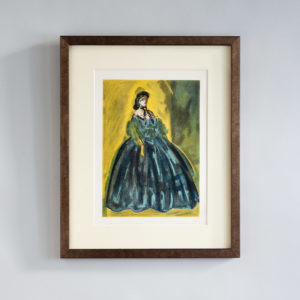
Portraits Part II by Constantin Guys, Verve Vol 2 / No. 5-6.
£500Portraits Part II by Constantin Guys, Verve Vol 2 / No. 5-6.
The Verve Review was a purposefully luxurious. It ran from 1937 to 1960, but with only 38 editions available, due to the high degree of design and editorial work dedicated to each issue. Each edition contained unique lithographic prints, commissioned by the editor, and each cover a double-page lithograph elaborated by one of the artists contained within. It was the brainchild of its editor Stratis Eleftheriades, a Greek National who moved to Paris in the early thirties to take part in the growing Modernist movement, writing under the name of Teriade.£500 -

Portraits Part I by Constantin Guys, Verve Vol 2 / No. 5-6.
£500Portraits Part I by Constantin Guys, Verve Vol 2 / No. 5-6.
The Verve Review was a purposefully luxurious. It ran from 1937 to 1960, but with only 38 editions available, due to the high degree of design and editorial work dedicated to each issue. Each edition contained unique lithographic prints, commissioned by the editor, and each cover a double-page lithograph elaborated by one of the artists contained within. It was the brainchild of its editor Stratis Eleftheriades, a Greek National who moved to Paris in the early thirties to take part in the growing Modernist movement, writing under the name of Teriade.£500 -

Joan Miró, Lithographie originale
£500Joan Miró, Lithographie originale
Joan Miró produced nearly 1,800 original lithographs and prints at the Maeght studio. He composed his score, invented his alphabet, scattered his symbols across the white page of his writing, close to graffiti. Everything was free, released, aerial, penetrated with interior light. He celebrated marriages between all techniques. Nothing was ever excessive or gratuitous. His creation cut to the essential. Miró created his own language. Dots, lines, scratches, graffiti, writing, mysterious anthropomorphic figures swimming or flying through infinite territory, fed by sparks. The power of black, awestruck colors… And the paper always defended its whiteness. Miró was about drawing above all else. His energy burst on to the sheet.£500 -

Joan Miró, Lithographie originale
£500Joan Miró, Lithographie originale
Joan Miró produced nearly 1,800 original lithographs and prints at the Maeght studio. He composed his score, invented his alphabet, scattered his symbols across the white page of his writing, close to graffiti. Everything was free, released, aerial, penetrated with interior light. He celebrated marriages between all techniques. Nothing was ever excessive or gratuitous. His creation cut to the essential. Miró created his own language. Dots, lines, scratches, graffiti, writing, mysterious anthropomorphic figures swimming or flying through infinite territory, fed by sparks. The power of black, awestruck colors… And the paper always defended its whiteness. Miró was about drawing above all else. His energy burst on to the sheet.£500 -

Joan Miró, Lithographie originale
£500Joan Miró, Lithographie originale
Joan Miró produced nearly 1,800 original lithographs and prints at the Maeght studio. He composed his score, invented his alphabet, scattered his symbols across the white page of his writing, close to graffiti. Everything was free, released, aerial, penetrated with interior light. He celebrated marriages between all techniques. Nothing was ever excessive or gratuitous. His creation cut to the essential. Miró created his own language. Dots, lines, scratches, graffiti, writing, mysterious anthropomorphic figures swimming or flying through infinite territory, fed by sparks. The power of black, awestruck colors… And the paper always defended its whiteness. Miró was about drawing above all else. His energy burst on to the sheet.£500 -

Joan Miró, Lithographie originale
£500Joan Miró, Lithographie originale
Joan Miró produced nearly 1,800 original lithographs and prints at the Maeght studio. He composed his score, invented his alphabet, scattered his symbols across the white page of his writing, close to graffiti. Everything was free, released, aerial, penetrated with interior light. He celebrated marriages between all techniques. Nothing was ever excessive or gratuitous. His creation cut to the essential. Miró created his own language. Dots, lines, scratches, graffiti, writing, mysterious anthropomorphic figures swimming or flying through infinite territory, fed by sparks. The power of black, awestruck colors… And the paper always defended its whiteness. Miró was about drawing above all else. His energy burst on to the sheet.£500 -

Joan Miró, Lithographie originale
£500Joan Miró, Lithographie originale
Joan Miró produced nearly 1,800 original lithographs and prints at the Maeght studio. He composed his score, invented his alphabet, scattered his symbols across the white page of his writing, close to graffiti. Everything was free, released, aerial, penetrated with interior light. He celebrated marriages between all techniques. Nothing was ever excessive or gratuitous. His creation cut to the essential. Miró created his own language. Dots, lines, scratches, graffiti, writing, mysterious anthropomorphic figures swimming or flying through infinite territory, fed by sparks. The power of black, awestruck colors… And the paper always defended its whiteness. Miró was about drawing above all else. His energy burst on to the sheet.£500 -

Joan Miró, Lithographie originale
£500Joan Miró, Lithographie originale
Joan Miró produced nearly 1,800 original lithographs and prints at the Maeght studio. He composed his score, invented his alphabet, scattered his symbols across the white page of his writing, close to graffiti. Everything was free, released, aerial, penetrated with interior light. He celebrated marriages between all techniques. Nothing was ever excessive or gratuitous. His creation cut to the essential. Miró created his own language. Dots, lines, scratches, graffiti, writing, mysterious anthropomorphic figures swimming or flying through infinite territory, fed by sparks. The power of black, awestruck colors… And the paper always defended its whiteness. Miró was about drawing above all else. His energy burst on to the sheet.£500 -

Joan Miró, Lithographie originale
£500Joan Miró, Lithographie originale
Joan Miró produced nearly 1,800 original lithographs and prints at the Maeght studio. He composed his score, invented his alphabet, scattered his symbols across the white page of his writing, close to graffiti. Everything was free, released, aerial, penetrated with interior light. He celebrated marriages between all techniques. Nothing was ever excessive or gratuitous. His creation cut to the essential. Miró created his own language. Dots, lines, scratches, graffiti, writing, mysterious anthropomorphic figures swimming or flying through infinite territory, fed by sparks. The power of black, awestruck colors… And the paper always defended its whiteness. Miró was about drawing above all else. His energy burst on to the sheet.£500 -

Joan Miró, Lithographie originale
£500Joan Miró, Lithographie originale
Joan Miró produced nearly 1,800 original lithographs and prints at the Maeght studio. He composed his score, invented his alphabet, scattered his symbols across the white page of his writing, close to graffiti. Everything was free, released, aerial, penetrated with interior light. He celebrated marriages between all techniques. Nothing was ever excessive or gratuitous. His creation cut to the essential. Miró created his own language. Dots, lines, scratches, graffiti, writing, mysterious anthropomorphic figures swimming or flying through infinite territory, fed by sparks. The power of black, awestruck colors… And the paper always defended its whiteness. Miró was about drawing above all else. His energy burst on to the sheet.£500 -

Joan Miró, Lithographie originale
£500Joan Miró, Lithographie originale
Joan Miró produced nearly 1,800 original lithographs and prints at the Maeght studio. He composed his score, invented his alphabet, scattered his symbols across the white page of his writing, close to graffiti. Everything was free, released, aerial, penetrated with interior light. He celebrated marriages between all techniques. Nothing was ever excessive or gratuitous. His creation cut to the essential. Miró created his own language. Dots, lines, scratches, graffiti, writing, mysterious anthropomorphic figures swimming or flying through infinite territory, fed by sparks. The power of black, awestruck colors… And the paper always defended its whiteness. Miró was about drawing above all else. His energy burst on to the sheet.£500 -
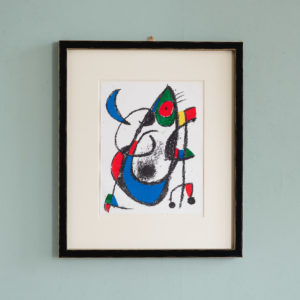
Joan Miró, Lithographie originale
£500Joan Miró, Lithographie originale
Joan Miró produced nearly 1,800 original lithographs and prints at the Maeght studio. He composed his score, invented his alphabet, scattered his symbols across the white page of his writing, close to graffiti. Everything was free, released, aerial, penetrated with interior light. He celebrated marriages between all techniques. Nothing was ever excessive or gratuitous. His creation cut to the essential. Miró created his own language. Dots, lines, scratches, graffiti, writing, mysterious anthropomorphic figures swimming or flying through infinite territory, fed by sparks. The power of black, awestruck colors… And the paper always defended its whiteness. Miró was about drawing above all else. His energy burst on to the sheet.£500
Featured Items
-

Portraits Part II by Constantin Guys, Verve Vol 2 / No. 5-6.
£500Portraits Part II by Constantin Guys, Verve Vol 2 / No. 5-6.
The Verve Review was a purposefully luxurious. It ran from 1937 to 1960, but with only 38 editions available, due to the high degree of design and editorial work dedicated to each issue. Each edition contained unique lithographic prints, commissioned by the editor, and each cover a double-page lithograph elaborated by one of the artists contained within. It was the brainchild of its editor Stratis Eleftheriades, a Greek National who moved to Paris in the early thirties to take part in the growing Modernist movement, writing under the name of Teriade.£500 -

Figure by Georges Braque, Verve Vol 2 / No. 5-6.
£800Figure by Georges Braque, Verve Vol 2 / No. 5-6.
The Verve Review was a purposefully luxurious. It ran from 1937 to 1960, but with only 38 editions available, due to the high degree of design and editorial work dedicated to each issue. Each edition contained unique lithographic prints, commissioned by the editor, and each cover a double-page lithograph elaborated by one of the artists contained within. It was the brainchild of its editor Stratis Eleftheriades, a Greek National who moved to Paris in the early thirties to take part in the growing Modernist movement, writing under the name of Teriade.£800 -

Portraits Part I by Constantin Guys, Verve Vol 2 / No. 5-6.
£500Portraits Part I by Constantin Guys, Verve Vol 2 / No. 5-6.
The Verve Review was a purposefully luxurious. It ran from 1937 to 1960, but with only 38 editions available, due to the high degree of design and editorial work dedicated to each issue. Each edition contained unique lithographic prints, commissioned by the editor, and each cover a double-page lithograph elaborated by one of the artists contained within. It was the brainchild of its editor Stratis Eleftheriades, a Greek National who moved to Paris in the early thirties to take part in the growing Modernist movement, writing under the name of Teriade.£500 -

Stars by Wassily Kandinsky, Verve Vol. 1 / No. 2.
£800Stars by Wassily Kandinsky, Verve Vol. 1 / No. 2.
The Verve Review was a purposefully luxurious. It ran from 1937 to 1960, but with only 38 editions available, due to the high degree of design and editorial work dedicated to each issue. Each edition contained unique lithographic prints, commissioned by the editor, and each cover a double-page lithograph elaborated by one of the artists contained within. It was the brainchild of its editor Stratis Eleftheriades, a Greek National who moved to Paris in the early thirties to take part in the growing Modernist movement, writing under the name of Teriade.£800

